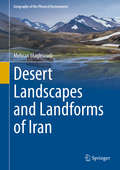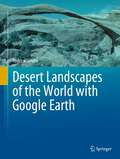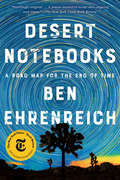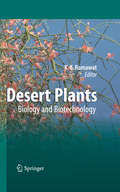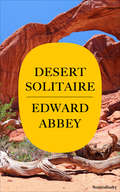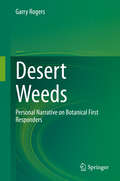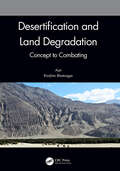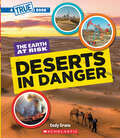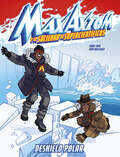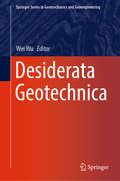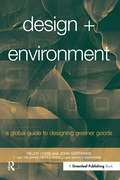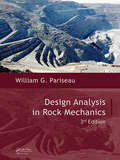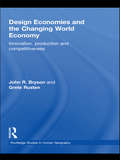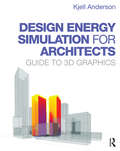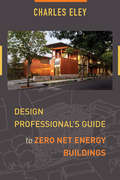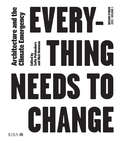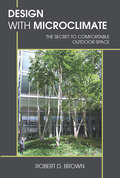- Table View
- List View
Desert Landscapes and Landforms of Iran (Geography of the Physical Environment)
by Mehran MaghsoudiThis book offers a unique and highly illustrated overview of the desert geomorphology of Iran. It describes the different landscapes and landforms of desert areas such as ergs and badlands offering a comprehensive insight into typical fluvial and eolian forms such as playas, alluvial fans, yardangs, salt domes, dunes, hoodoos and many more. The monograph elaborates the interaction of humans with the landscapes and discusses ongoing developments in geotourism, natural heritage sites as well as the potential for geoparks. Desert Landscapes and Landforms of Iran contains many photographs, satellite images, high-resolution aerial photos, maps, charts and tables which build a nice framework for the assessment of the different geomorphological features. It constitutes a comprehensive introduction for researchers and students of many disciplines in the fields of geography, geosciences, tourism and leisure studies, environmental sciences and landscape planning interested in typical physical characteristics of desert landscapes.
Desert Landscapes of the World with Google Earth
by Andrew GoudieThis book presents an introduction to desert landscapes—primarily landforms that are natural and man-made. It is based around the presentation of a series of beautiful and informative annotated Google Earth images. These are accompanied by text that describes the feature(s) concerned, their location, and their origin. There are also, in some cases, ground images taken by the author.
Desert Notebooks: A Road Map for the End of Time
by Ben EhrenreichLayering climate science, mythologies, nature writing, and personal experiences, this New York Times Notable Book presents a stunning reckoning with our current moment and with the literal and figurative end of time.Desert Notebooks examines how the unprecedented pace of destruction to our environment and an increasingly unstable geopolitical landscape have led us to the brink of a calamity greater than any humankind has confronted before. As inhabitants of the Anthropocene, what might some of our own histories tell us about how to confront apocalypse? And how might the geologies and ecologies of desert spaces inform how we see and act toward time—the pasts we have erased and paved over, this anxious present, the future we have no choice but to build? Ehrenreich draws on the stark grandeur of the desert to ask how we might reckon with the uncertainty that surrounds us and fight off the crises that have already begun.In the canyons and oases of the Mojave and in Las Vegas&’s neon apocalypse, Ehrenreich finds beauty, and even hope, surging up in the most unlikely places, from the most barren rocks, and the apparent emptiness of the sky. Desert Notebooks is a vital and necessary chronicle of our past and our present—unflinching, urgent—yet timeless and profound.
Desert Paradises: Surveying the Landscapes of Dubai’s Urban Model (Routledge Research in Landscape and Environmental Design)
by Julian BolleterDesert Paradises: Surveying the Landscapes of Dubai’s Urban Model explores how designed landscapes can play a vital role in constructing a city’s global image and legitimizing its socio-political hierarchy. Using the case study of Dubai, Bolleter explores how Dubai’s rulers employ a paradisiacal image of greening the desert, in part, as a tool for political legitimization. Bolleter also evaluates the designed landscapes of Dubai against the principles of the United Nations and the International Federation of Landscape Architects and argues that what is happening in Dubai represents a significant discrepancy between theory and practice. This book offers a new perspective on landscape design that has until now been unexplored. It would be beneficial to academics and students of geography, landscape architecture, urban design and urban planning – particularly those with an interest in Dubai or the many cities in the region that are experiencing Dubaiification.
Desert Plants
by Kishan Gopal RamawatVast areas of Earth's landmass exist as deserts, representing quite distinct ecosystems. Desert plants and animals have evolved specialised survival strategies to cope with the harsh environment of high temperatures and scarce water resources. The life-supporting vegetation of deserts is characterised by its unique reproductive biology, metabolism and adaptive characters. Plants like Prosopis cineraria and date palm form the basis of the rural economy in many countries, and are of great cultural importance; Jojoba and Jatropha have attracted interest as non-conventional sources of industrial oil and biodiesel. This book includes chapters on the seed biology, reproduction, mycorrhizae, stress physiology, and metabolism of desert plants, and describes current biotechnological approaches to their cultivation. It will be useful to researchers, teachers and students in the fields of plant sciences, agriculture, and forestry, and those involved in the management and conservation of desert ecosystems.
Desert Solitaire: A Season In The Wilderness
by Edward AbbeyThis memoir of life in the American desert by the author of The Monkey Wrench Gang is a nature writing classic on par with Rachel Carson&’s Silent Spring. In Desert Solitaire, Edward Abbey recounts his many escapades, adventures, and epiphanies as an Arches National Park ranger outside Moab, Utah. Brimming with arresting insights, impassioned arguments for wilderness conservation, and a raconteur&’s wit, it is one of Abbey&’s most critically acclaimed works. Through stories and philosophical musings, Abbey reflects on the condition of our remaining wilderness, the future of a civilization, and his own internal struggle with morality. As the world continues its rapid development, Abbey&’s cry to maintain the natural beauty of the West remains just as relevant today as when this book first appeared in 1968.
Desert Weeds: Personal Narrative on Botanical First Responders
by Garry RogersIn their rapid colonization of soil exposed by fires, floods, and grazing animals, weeds resemble the human specialists we label Emergency Medical Technicians (EMTs). Weeds are the first responders when disasters occur in nature. They occupy bare soil and prevent erosion by wind and water. In extreme cases such as a landslide, weeds are essential to the healing processes that replace the lost soil. Like a Band-Aid on a skinned knee, weeds protect the land while it recovers. Besides protecting the soil after disaster, weeds provide food for wildlife, and some of them provide food and medicine for people. Able to withstand harsh conditions, weeds will proliferate as global warming and other human impacts intensify. Thus, nature’s EMTs will increase while all other plants decline. The book provides a succinct definition of weeds according to their form and function in ecosystem processes. The narrative uses a representative set of weed species from a desert location to illustrate the full range of weed characteristics.
Desertification and Land Degradation: Concept to Combating
by Ajai Rimjhim BhatnagarDesertification and land degradation are complex phenomena, and we need to understand their causes, consequences, and means to mitigate and combat their impact. Therefore, this book aims to explain the concept and characteristics of drylands, desert and desertification, land degradation, wastelands, and the concept of ecosystem services. It also discusses various types of processes of land degradations, their characteristics, physics and indicators along with mapping, monitoring and assessment of methods involved. Concept of Ocean Biological Deserts is discussed along with international and regional efforts towards combating land degradation and desertification. Key Features:• Provides all the aspect of desertification and land degradation at one place • Includes comprehensive methods to monitor different desertification/land degradation processes • Comprehensive overview of the mapping, monitoring and modelling techniques • Role of space borne data in identifying, monitoring and combating desertification is evaluated and reported with real case studies • Explains the concept of ocean biological deserts, their characteristics and mapping
Deserts
by Donna LathamInvestigating the planet's biomes and examining the modern threats to each ecosystem, this interactive series challenges young readers to look at how their own actions influence the planet's health. With compare-and-contrast facts and vocabulary-building sidebars, each engaging guide reveals how environmental threats-both human and natural-affect plants and animals. Examining this growing biome, this guide shows that the desert is more than just a giant sandbox. Discussing desertification and how environmental change-such as ranching, overdevelopment, and cactus collection-in this area can threaten life outside the desert, this resource instructs students on the need to treat the desert with care.
Deserts in Danger (A True Book (Relaunch))
by Cody CraneDiscover the rich biodiversity of Earth's biomes - and how they might be saved - with this STEAM-based subset of True Books.Did you know that the Sahara is the world's largest hot desert? Or that Antarctica is the world's largest cold desert? Get ready to investigate the driest places on the planet, hot and cold, as well as the plants and animals that have adapted to survive there. You'll also learn about the many threats facing this fascinating biome - and what each of us can do to help - all in the pages of Deserts in Danger.ABOUT THE SERIES:There are five major biomes on Earth: desert, forest, grassland, aquatic, and tundra. These rich, wild places are home to a wide variety of plants and animals - many of which are found nowhere else. Unfortunately, these ecosystems have been put at risk by human activities. This STEAM-based set of True Books introduces students to the incredible biodiversity of Earth's amazing biomes, as well as the threats they face in the era of climate change. Interesting information is presented in a fun, friendly way - and in the simplest terms possible - and will inspire kids to think about how they can help stop the destruction of Earth's wild spaces.
Deserts: A True Book
by Darlene R. StillePresents a general description of deserts and describes specific desert plants, animals, people, and activities.
Deshielo polar: una aventura de Max Axiom, súpercientífico (Max Axiom y la sociedad de supercientíficos)
by Carol Kim¡El hielo del Ártico está desapareciendo! Pero ¿por qué se derriten las cimas nevadas, los glaciares y los icebergs? En esta novela gráfica de no ficción, Max Axiom y la Sociedad de supercientíficos tienen la misión de averiguarlo. Utilizando sus superpoderes y su superinteligencia, el equipo desglosará cada pieza de este complejo problema medioambiental en una aventura emocionante e informativas para que los jóvenes lectores aprendan sobre las causas y los efectos del cambio climático y descubrir las medidas que todos podemos tomar para proteger las regiones polares y combatir el calentamiento global.
Desiderata Geotechnica (Springer Series in Geomechanics and Geoengineering)
by Wei WuThis book presents contributions to a workshop dedicated to Prof. Gerd Gudehus on the occasion of his 80th birthday and held in Vienna, Austria, on 14-16 August 2018. The articles gathered here, many of which were written by former students, friends and colleagues of Prof. Gudehus, cover diverse topics that reflect the breadth and depth of geomechanics research. Consequently, they offer a valuable source of ideas and inspiration on areas ranging from sophisticated constitutive models to advanced numerical methods, from particles to continua, and from fractals of geomaterials to the design of offshore wind turbine foundations.
Design + Environment: A Global Guide to Designing Greener Goods
by Helen Lewis Tim Grant John Gertsakis Nicola Morelli Andrew SweatmanThere is a huge scarcity of good, practical resources for designers and students interested in minimizing the environmental impacts of products. Design + Environment has been specifically written to address this paucity. The book first provides background information to help the reader understand how and why design for environment (DfE) has become so critical to design, with reference to some of the most influential writers, designers and companies in the field. Next, Design + Environment provides a step-by-step approach on how to approach DfE: to design a product that meets requirements for quality, cost, manufacturability and consumer appeal, while at the same time minimising environmental impacts. The first step in the process is to undertake an assessment of environmental impacts, using life-cycle assessment (LCA) or one of the many simpler tools available to help the designer. From then on, DfE becomes an integral part of the normal design process, including the development of concepts, design of prototypes, final design and development of marketing strategies. Environmental assessment tools and strategies to reduce environmental impacts, such as the selection of appropriate materials, are then discussed. Next, some of the links between environmental problems, such as global warming, ozone depletion, water and air pollution and the everyday products we consume are considered. In order to design products with minimal environmental impact, we need to have a basic understanding of these impacts and the interactions between them. The four subsequent chapters provide more detailed strategies and case studies for particular product groups: packaging, textiles, furniture, and electrical and electronic products. Guidelines are provided for each of the critical stages of a product's life, from the selection of raw materials through to strategies for recovery and recycling. Finally, Design + Environment takes a look at some of the emerging trends in DfE that are offering us the opportunity to make a more significant reduction in environmental impacts. Both the development of more sustainable materials and technologies and the growing interest in leasing rather than selling products are examined. Design + Environment is organized as a workbook rather than an academic text. It should be read once, and then used as a key reference source. This clear and informative book will prove to be invaluable to practising designers, to course directors and their students in need of a core teaching and reference text and to all those interested in learning about the tools and trends influencing green product design. The authors have all been involved in an innovative demonstration programme called "EcoReDesign", which was developed by the Centre for Design at RMIT University with funding from the Australian government. The Centre successfully collaborated with Australian companies to improve the environmental performance of their products by following DfE principles.
Design Analysis in Rock Mechanics
by William G. PariseauThis comprehensive introduction to rock mechanics treats the basics of rock mechanics in a clear and straightforward manner and discusses important design problems in terms of the mechanics of materials. This extended third edition includes an additional chapter on Foundations on Jointed Rock. Developed for a complete class in rock engineering, this volume uniquely combines the design of surface and underground rock excavations and addresses:• rock slope stability in surface excavations, from planar block and wedge slides to rotational and toppling failures • shaft and tunnel stability, ranging from naturally-supported openings to analysis and design of artificial support and reinforcement systems • entries and pillars in stratified ground • three-dimensional caverns, with emphasis on cable bolting and backfill • geometry and forces of chimney caving, combination support and trough subsidence • rock bursts and bumps in underground excavations, with focus on dynamic phenomena and on fast and sometimes catastrophic failures. The numerous exercises and examples familiarize the reader with solving basic practical problems in rock mechanics through various design analysis techniques and their applications. Supporting the main text, appendices provide supplementary information about rock, joint, and composite properties, rock mass classification schemes, useful formulas, and an extensive literature list. The large selection of problems at the end of each chapter can be used for home assignment. A solutions manual is available to course instructors. Explanatory and illustrative in character, this volume is suited for courses in rock mechanics, rock engineering and geological engineering design for undergraduate and first year graduate students in mining, civil engineering and applied earth sciences. Moreover, it will form a good introduction to the subject of rock mechanics for earth scientists and engineers from other disciplines.
Design Economies and the Changing World Economy: Innovation, Production and Competitiveness (Routledge Studies in Human Geography)
by Grete Rusten John R. BrysonDesign is central to every service or good produced, sold and consumed. Manufacturing and service companies located in high cost locations increasingly find it difficult to compete with producers located in countries such as India and China. Companies in high-cost locations either have to shift production abroad or create competitive advantage through design, innovation, brand and the geographic distribution of tasks rather than price. Design Economies and the Changing World Economy provides the first comprehensive account of the relationship between innovation, design, corporate competitiveness and place. Design economies are explored through an analysis of corporate strategies, the relationship between product and designer, copying and imitation including nefarious learning, design and competitiveness, and design-centred regional policies. The design process plays a critical role in corporate competitiveness as it functions at the intersection between production and consumption and the interface between consumer behaviour and the development and design of products. This book focuses on firms, individuals, as well as national policy, drawing attention to the development of corporate and nation based design strategies that are intended to enhance competitive advantage. Increasingly products are designed in one location and made in another. This separation of design from the place of production highlights the continued development of the international division of labour as tasks are distributed in different places, but blended together to produce design-intensive branded products. This book provides a distinctive analysis of the ways in which companies located in developed market economies compete on the basis of design, brand and the geographic distribution of tasks. The text contains case studies of major manufacturing and service companies and will be of valuable interest to students and researchers interested in Geography, Economics and Planning.
Design Education in India: Values of Socially Responsible Design (Routledge Research in Social Design)
by Sanjeev BothraThis book traces developments in design education in India and shows the continuing impact of the Bauhaus School of design education, which formed the basis of the National Institute of Design. It presents the findings of the author's research and experiential learning as a design educator over a 25-year period. This book argues that as the effects of climate change and the exploitation of natural and human resources become more pervasive, it has become increasingly important to ensure that the values of social responsibility are instilled into the design students who will become future practitioners. This book offers an alternative model of understanding regarding the ecosystem of design and sustainable design education. Going beyond description and analysis, it includes three case studies of adoptable design curricula created by the author, with student responses to the programmes to provide first-hand insights into their impact. Research findings are based on detailed interviews with contemporary faculty members, all experts in the various design disciplines, along with an in-depth survey of existing design programmes in India. Design Education in India encourages a paradigm shift in thinking about the environment, spaces and places. It offers a unique perspective on the status of design education in an important and fast-growing economy and will be a useful read for design educators and researchers in varied disciplines.
Design Energy Simulation for Architects: Guide to 3D Graphics
by Kjell AndersonLeading architectural firms are now using in-house design simulation to help make more sustainable design decisions. Taking advantage of these new tools requires understanding of what can be done with simulation, how to do it, and how to interpret the results. This software-agnostic book, which is intended for you to use as a professional architect, shows you how to reduce the energy use of all buildings using simulation for shading, daylighting, airflow, and energy modeling. Written by a practicing architect who specializes in design simulation, the book includes 30 case studies of net-zero buildings, as well as of projects with less lofty goals, to demonstrate how energy simulation has helped designers make early decisions. Within each case study, author Kjell Anderson mentions the software used, how the simulation was set up, and how the project team used the simulation to make design decisions. Chapters and case studies are written so that you learn general concepts without being tied to particular software. Each chapter builds on the theory from previous chapters, includes a summary of concept-level hand calculations (if applicable), and gives comprehensive explanations with graphic examples. Additional topics include simulation basics, comfort, climate analysis, a discussion on how simulation is integrated into some firms, and an overview of some popular design simulation software.
Design Like Nature: Biomimicry for a Healthy Planet (Orca Footprints #20)
by Megan Clendenan Kim Ryall Woolcock★“Fascinating…An appealing resource sure to spark an interest in biomimicry, from casual readers to budding scientists. Recommended for all libraries.”—School Library Journal, starred review Did you know that lamps can be powered by glowing bacteria instead of electricity? That gloves designed like gecko feet let people climb straight up glass walls? Or that kids are finding ways to make compostable plastic out of banana peels? Biomimicry, the scientific term for when we learn from and copy nature, is a revolutionary way to look to nature for answers to environmental problems such as climate change. In Design Like Nature young readers discover innovations and inventions inspired by the environment. Nature runs the entire planet with no waste and no pollution. Can humans learn to do this too? It's time to step outside and start designing like nature.
Design Methodology in Rock Engineering
by Z.T. BieniawskiThe first comprehensive treatment of the subject of design methodology in rock engineering, this book emphasizes that a good designer needs not only knowledge for designing (technical knowledge) but also must have knowledge about designing (an appropriate process to follow). Design methodology is today recognized in most fields as crucial to the success of a new product, process, or construction project.This unique book starts with an appraisal of current trends concerning global design activities and competitiveness and gives an insight into how designers design. The state of the art in engineering design is given with a detailed exposé of all significant design theories and methodologies. It then presents a design methodology specifically for rock engineering and demonstrates its practical use on the basis of important case histories. To preserve the momentum of the design message, design education is also discussed. A separate chapter is devoted to skills development, presenting the designer with an extensive repertoire of widely available tools and concepts. The Appendix lists a compendium of useful design charts for rock engineering, traced after a thorough literature search. A Bibliography concludes the book with an up-to-date list of references.
Design Professional's Guide to Zero Net Energy Buildings
by Charles EleyIn the United States, direct energy use in buildings accounts for 39% of carbon dioxide emissions per year--more than any other sector. Buildings contribute to a changing climate and warming of the earth in ways that will significantly affect future generations. Zero net energy (ZNE) buildings are a practical and cost-effective way to reduce our energy needs, employ clean solar and wind technologies, protect the environment, and improve our lives. Interest in ZNE buildings, which produce as much energy as they use over the course of a year, has been growing rapidly.In the Design Professional's Guide to Zero Net Energy Buildings, Charles Eley draws from over 40 years of his own experience, and interviews with other industry experts, to lay out the principles for achieving ZNE buildings and the issues surrounding their development. Eley emphasizes the importance of building energy use in achieving a sustainable future; describes how building energy use can be minimized through smart design and energy efficiency technologies; and presents practical information on how to incorporate renewable energy technologies to meet the lowered energy needs. The book identifies the building types and climates where meeting the goal will be a challenge and offers solutions for these special cases. It shows the reader, through examples and explanations, that these solutions are viable and cost-effective.ZNE buildings are practical and cost-effective ways to address climate change without compromising our quality of life. ZNE buildings are an energizing concept and one that is broadly accepted yet, there is little information on what is required to actually meet these goals. This book shows that the goal is feasible and can be practically achieved in most buildings, that our construction industry is up to the challenge, and that we already have the necessary technologies and knowledge.
Design Studio Vol. 1: Architecture and the Climate Emergency
by Sofie Pelsmakers; Nick NewmanWant to keep up with emerging design thinking and issues worldwide? Design Studio is a new thematic series that distils the most topical work and ideas from schools and practices globally. The first volume launches with a statement: Everything Needs to Change. Exploring architecture and the climate emergency, editors Sofie Pelsmakers (author of Environmental Design Sourcebook) and Nick Newman (climate activist and Director at Studio Bark), are channelling the message of Greta Thunberg to inspire, enthuse and inform the next generation of architects. Featuring articles, building profiles and case studies from a range of leading voices, it explores solutions to climatic, environmental and social challenges. It urges readers to radically rethink what it means to be an architect in an era of climate crisis, and what the role of the architect is or can be. Discover how using local materials, working with nature, radical design processes, transformative learning and activism can help us find hope in the burning world. Together, we can force change for a more sustainable and equitable tomorrow. This first volume is produced in four unique fluorescent colours – green, red, yellow and purple – to be your own poster for change.
Design Studio Vol. 4: Architecture After the Anthropocene
by Harriet Harriss Naomi HouseWithout environmental justice, there can be no social justice. This volume sets the table for inclusive architectural engagement during a time circumscribed by pandemic, climate change and inequality. An esteemed group of international voices amplify interactions involving sexism, racism, classism, homophobia, transphobia and environmental catastrophe, exploring how they inextricably linked. Without acknowledging the interconnectedness of these injustices, we will not find effective ways to halt the deepening crisis. Features: Marcos Cruz, Casper Laing Ebbensgaard, Antón García-Abril, Alexandra Daisy Ginsburg, Ariane Lourie Harrison, Kerry Holden, Walter Hood, Joyce Hwang, Kabage Karanja, V. Mitch McEwen, Débora Mesa, Timothy Morton, Stella Mutegi, Brenda Parker, Carolyn Steel, McKenzie Wark, Kathryn Yusoff and Joanna Zylinska.
Design With Microclimate: The Secret to Comfortable Outdoor Space
by Robert D. BrownRobert Brown helps us see that a "thermally comfortable microclimate" is the very foundation of well-designed and well-used outdoor places. Brown argues that as we try to minimize human-induced changes to the climate and reduce our dependence on fossil fuels-as some areas become warmer, some cooler, some wetter, and some drier, and all become more expensive to regulate-good microclimate design will become increasingly important. In the future, according to Brown, all designers will need to understand climatic issues and be able to respond to their challenges. Brown describes the effects that climate has on outdoor spaces-using vivid illustrations and examples-while providing practical tools that can be used in everyday design practice. The heart of the book is Brown's own design process, as he provides useful guidelines that lead designers clearly through the complexity of climate data, precedents, site assessment, microclimate modification, communication, design, and evaluation. Brown strikes an ideal balance of technical information, anecdotes, examples, and illustrations to keep the book engaging and accessible. His emphasis throughout is on creating microclimates that attend to the comfort, health, and well-being of people, animals, and plants. Design with Microclimate is a vital resource for students and practitioners in landscape architecture, architecture, planning, and urban design.
